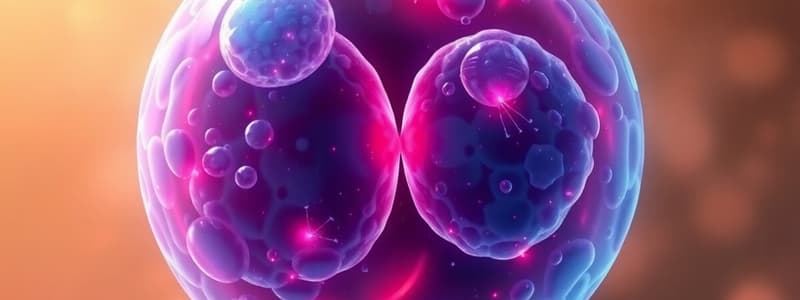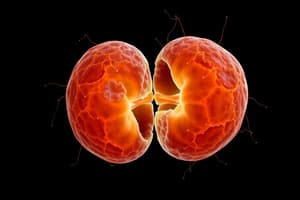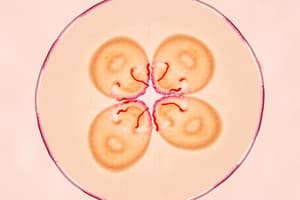Podcast
Questions and Answers
What is the primary function of mitosis in multicellular organisms?
What is the primary function of mitosis in multicellular organisms?
- To repair damaged tissues (correct)
- To reduce genetic diversity
- To produce gametes for reproduction
- To create genetically unique cells
During which phase of cell division do sister chromatids separate?
During which phase of cell division do sister chromatids separate?
- Anaphase (correct)
- Telophase
- Metaphase
- Prophase
Which process occurs during prophase I of meiosis that contributes to genetic diversity?
Which process occurs during prophase I of meiosis that contributes to genetic diversity?
- Cytokinesis
- Crossing over (correct)
- Nuclear envelope formation
- Independent assortment
What type of cells are produced by meiosis?
What type of cells are produced by meiosis?
Which phase of the cell cycle is primarily responsible for DNA replication?
Which phase of the cell cycle is primarily responsible for DNA replication?
What is the significance of checkpoints in the cell cycle?
What is the significance of checkpoints in the cell cycle?
What is the end result of meiosis II?
What is the end result of meiosis II?
What role does the spindle apparatus play during cell division?
What role does the spindle apparatus play during cell division?
Which of the following statements is false about mitosis?
Which of the following statements is false about mitosis?
Which key phase of meiosis results in the reduction of chromosome number?
Which key phase of meiosis results in the reduction of chromosome number?
What is the primary purpose of meiosis in multicellular organisms?
What is the primary purpose of meiosis in multicellular organisms?
Which proteins are crucial for regulating the cell cycle?
Which proteins are crucial for regulating the cell cycle?
What type of changes can result from errors in cell division?
What type of changes can result from errors in cell division?
How does mitosis differ from meiosis in terms of chromosome number in daughter cells?
How does mitosis differ from meiosis in terms of chromosome number in daughter cells?
What can uncontrolled cell division lead to?
What can uncontrolled cell division lead to?
Which type of genes typically promote uncontrolled cell division?
Which type of genes typically promote uncontrolled cell division?
What does aneuploidy refer to in the context of cell division errors?
What does aneuploidy refer to in the context of cell division errors?
What is the consequence of improper regulation in the cell cycle?
What is the consequence of improper regulation in the cell cycle?
What do cyclins and cyclin-dependent kinases (CDKs) primarily regulate in the cell cycle?
What do cyclins and cyclin-dependent kinases (CDKs) primarily regulate in the cell cycle?
What role does crossing over play in meiosis compared to mitosis?
What role does crossing over play in meiosis compared to mitosis?
Flashcards
What is cell division?
What is cell division?
Cell division is a fundamental biological process that creates new cells from existing ones. It is crucial for growth, repair, and reproduction in all living organisms.
What are the two main types of cell division?
What are the two main types of cell division?
Mitosis and meiosis are the two main types of cell division. Mitosis produces identical daughter cells for growth and repair, while meiosis generates genetically unique gametes for sexual reproduction.
What happens during mitosis?
What happens during mitosis?
Mitosis is a process of cell division resulting in two identical daughter cells from a single parent cell. This ensures accurate chromosome duplication and segregation, crucial for growth and repair.
What are the phases of mitosis?
What are the phases of mitosis?
Signup and view all the flashcards
What is the cell cycle?
What is the cell cycle?
Signup and view all the flashcards
What is meiosis?
What is meiosis?
Signup and view all the flashcards
How does meiosis occur?
How does meiosis occur?
Signup and view all the flashcards
What is crossing over?
What is crossing over?
Signup and view all the flashcards
What is independent assortment?
What is independent assortment?
Signup and view all the flashcards
Why is cell division important?
Why is cell division important?
Signup and view all the flashcards
Mitosis
Mitosis
Signup and view all the flashcards
Meiosis
Meiosis
Signup and view all the flashcards
Cell cycle regulation
Cell cycle regulation
Signup and view all the flashcards
Cyclins and CDKs
Cyclins and CDKs
Signup and view all the flashcards
Aneuploidy
Aneuploidy
Signup and view all the flashcards
Errors in cell division
Errors in cell division
Signup and view all the flashcards
Cancer
Cancer
Signup and view all the flashcards
Tumor suppressor genes
Tumor suppressor genes
Signup and view all the flashcards
Oncogenes
Oncogenes
Signup and view all the flashcards
Cancer treatments
Cancer treatments
Signup and view all the flashcards
Study Notes
Introduction to Cell Division
- Cell division is a fundamental process in all living organisms, crucial for growth, repair, and reproduction.
- Two main types exist: mitosis and meiosis.
- Mitosis produces genetically identical daughter cells, essential for increasing cell number in somatic tissues.
- Meiosis produces genetically unique daughter cells, vital for sexual reproduction.
Mitosis
- Mitosis is a process that results in two identical daughter cells from a single parent cell.
- It involves a series of precisely orchestrated steps, ensuring accurate chromosome duplication and segregation.
- Key phases include prophase, metaphase, anaphase, and telophase.
- Prophase: Chromosomes condense, the nuclear envelope breaks down, and the spindle apparatus forms.
- Metaphase: Chromosomes align at the metaphase plate.
- Anaphase: Sister chromatids separate and move to opposite poles.
- Telophase: Chromosomes decondense, the nuclear envelope reforms, and the cell prepares to divide.
- Cytokinesis is the final step, where the cytoplasm divides to form two separate daughter cells.
- Crucial for growth, repair, and asexual reproduction.
Meiosis
- Meiosis is involved in sexual reproduction, producing gametes (sperm and egg cells).
- It involves two rounds of cell division (meiosis I and meiosis II).
- Meiosis I: Homologous chromosomes separate, reducing chromosome number by half.
- Meiosis II: Sister chromatids separate, similar to mitosis.
- Meiosis generates genetic diversity through crossing over and independent assortment.
- Crossing over: Exchange of genetic material between homologous chromosomes during prophase I.
- Independent assortment: Random alignment of homologous chromosomes during metaphase I.
- Results in haploid gametes, containing half the number of chromosomes compared to the parent cell.
Phases of the Cell Cycle
- The cell cycle is a series of events that takes place in a cell leading to its division and duplication.
- It consists of interphase and the mitotic phase (mitosis and cytokinesis).
- Interphase includes G1 (gap 1), S (synthesis), and G2 (gap 2) phases.
- G1: Cell growth and normal cellular functions.
- S: DNA replication occurs.
- G2: Cell continues to grow and prepares for mitosis.
- Checkpoint mechanisms regulate progression through the cell cycle, ensuring accuracy in DNA replication and distribution.
Significance of Cell Division
- Essential for growth of organisms.
- Essential for tissue repair and regeneration in multicellular organisms.
- Crucial for reproduction by asexual means.
- Supports the development and maintenance of complex multicellular organisms.
- Maintaining the ploidy level (the number of sets of chromosomes).
Cell Cycle Regulation
- Cell cycle progression is strictly regulated at key checkpoints.
- Absence of proper regulation can lead to uncontrolled cell division, a characteristic of cancer.
- Proteins like cyclins and cyclin-dependent kinases (CDKs) control the cycle.
- These proteins regulate the transition between different phases.
- Errors in the cell cycle can lead to improper chromosome segregation, affecting the genetic material of daughter cells.
Differences between Mitosis and Meiosis
- Mitosis produces two diploid daughter cells, while meiosis produces four haploid daughter cells.
- Mitosis is primarily for growth and repair, whereas meiosis is for sexual reproduction.
- Mitosis maintains chromosome number, while meiosis reduces it by half.
- Mitosis does not involve crossing over; meiosis does.
Errors in Cell Division
- Errors in cell division can lead to developmental abnormalities, genetic disorders.
- Errors can be due to mutations or environmental factors.
- Aneuploidy: Abnormal number of chromosomes.
- Deletions, inversions, and translocations are structural chromosomal changes, which can be inherited or occur as a result of environmental factors.
- Improper regulation can result in uncontrolled cell growth, leading to cancer.
Cancer and Cell Division
- Cancer involves uncontrolled cell division, resulting in the formation of tumors.
- Mutations in genes that regulate the cell cycle can lead to cancer.
- Tumor suppressor genes normally inhibit cell growth, and oncogenes promote uncontrolled cell division.
- Various treatment strategies target abnormal cell division in cancer cells.
Studying That Suits You
Use AI to generate personalized quizzes and flashcards to suit your learning preferences.




